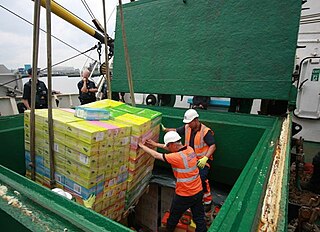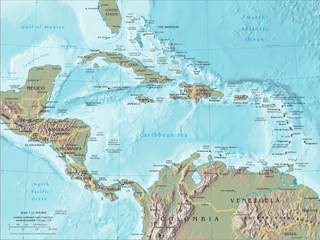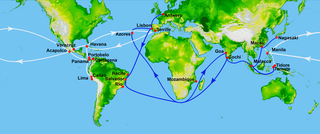Related Research Articles

The Dominican Republic is a country located on the island of Hispaniola in the Greater Antilles archipelago of the Caribbean region. It occupies the eastern five-eighths of the island, which it shares with Haiti, making Hispaniola one of only two Caribbean islands, along with Saint Martin, that is shared by two sovereign states. The Dominican Republic is the second-largest nation in the Antilles by area at 48,671 square kilometers (18,792 sq mi), and third-largest by population, with approximately 10.7 million people, down from 10.8 million in 2020, of whom approximately 3.3 million live in the metropolitan area of Santo Domingo, the capital city. The official language of the country is Spanish.

The recorded history of the Dominican Republic began in 1492 when the Genoa-born navigator Christopher Columbus, working for the Crown of Castile, happened upon a large island in the region of the western Atlantic Ocean that later came to be known as the Caribbean. It was inhabited by the Taíno, an Arawakan people, who called the eastern part of the island Quisqueya (Kiskeya), meaning "mother of all lands." Columbus promptly claimed the island for the Spanish Crown, naming it La Isla Española, later Latinized to Hispaniola. After 25 years of Spanish occupation, the Taíno population in the Spanish-dominated parts of the island drastically decreased through genocide. With fewer than 50,000 remaining, the survivors intermixed with Spaniards, Africans, and others, forming the present-day tripartite Dominican population. What would become the Dominican Republic was the Spanish Captaincy General of Santo Domingo until 1821, except for a time as a French colony from 1795 to 1809. It was then part of a unified Hispaniola with Haiti from 1822 until 1844. In 1844, Dominican independence was proclaimed and the republic, which was often known as Santo Domingo until the early 20th century, maintained its independence except for a short Spanish occupation from 1861 to 1865 and occupation by the United States from 1916 to 1924.

Hispaniola is an island in the Caribbean that is part of the Greater Antilles and Antilles. Hispaniola is the most populous island in the West Indies, and the region's second largest in area, after the island of Cuba.

Smuggling is the illegal transportation of objects, substances, information or people, such as out of a house or buildings, into a prison, or across an international border, in violation of applicable laws or other regulations. More broadly, social scientists define smuggling as the purposeful movement across a border in contravention to the relevant legal frameworks.

The War of Jenkins' Ear, or Guerra del Asiento, was a conflict lasting from 1739 to 1748 between Britain and Spain. The majority of the fighting took place in New Granada and the Caribbean Sea, with major operations largely ended by 1742. It was related to the 1740 to 1748 War of the Austrian Succession. The name was coined in 1858 by British historian Thomas Carlyle, and refers to Robert Jenkins, captain of the British brig Rebecca, whose ear was allegedly severed by Spanish coast guards while searching his ship for contraband in April 1731.

The history of the Caribbean reveals the significant role the region played in the colonial struggles of the European powers since the 15th century. In the modern era, it remains strategically and economically important. In 1492, Christopher Columbus landed in the Caribbean and claimed the region for Spain. The following year, the first Spanish settlements were established in the Caribbean. Although the Spanish conquests of the Aztec empire and the Inca empire in the early sixteenth century made Mexico and Peru more desirable places for Spanish exploration and settlement, the Caribbean remained strategically important.

Santo Domingo, once known as Santo Domingo de Guzmán and formerly known as Ciudad Trujillo, is the capital and largest city of the Dominican Republic and the largest metropolitan area in the Caribbean by population. As of 2022, the city and immediate surrounding area had a population of 1,029,110 while the total population is 3,798,699 when including Greater Santo Domingo. The city is coterminous with the boundaries of the Distrito Nacional, itself bordered on three sides by Santo Domingo Province.

The era of piracy in the Caribbean began in the 1500s and phased out in the 1830s after the navies of the nations of Western Europe and North America with colonies in the Caribbean began combating pirates. The period during which pirates were most successful was from the 1660s to 1730s. Piracy flourished in the Caribbean because of the existence of pirate seaports such as Port Royal in Jamaica, Tortuga in Haiti, and Nassau in the Bahamas. Piracy in the Caribbean was part of a larger historical phenomenon of piracy, as it existed close to major trade and exploration routes in almost all the five oceans.

The Spanish treasure fleet, or West Indies Fleet, was a convoy system of sea routes organized by the Spanish Empire from 1566 to 1790, which linked Spain with its territories in the Americas across the Atlantic. The convoys were general purpose cargo fleets used for transporting a wide variety of items, including agricultural goods, lumber, various metal resources such as silver and gold, gems, pearls, spices, sugar, tobacco, silk, and other exotic goods from the overseas territories of the Spanish Empire to the Spanish mainland. Spanish goods such as oil, wine, textiles, books and tools were transported in the opposite direction.

The Asiento de Negros was a monopoly contract between the Spanish Crown and various merchants for the right to provide African slaves to colonies in the Spanish Americas. The Spanish Empire rarely engaged in the trans-Atlantic slave trade directly from Africa itself, choosing instead to contract out the importation to foreign merchants from nations more prominent in that part of the world; typically Portuguese and Genoese, but later the Dutch, French, and British. The Asiento did not concern French or British Caribbean but Spanish America.

The Bourbon Reforms consisted of political and economic changes promulgated by the Spanish Crown under various kings of the House of Bourbon, since 1700, mainly in the 18th century. The beginning of the new Crown's power with clear lines of authority to officials contrasted to the complex system of government that evolved under the Habsburg monarchs. For example, the crown pursued state predominance over the Catholic Church, pushed economic reforms, and placed power solely into the hands of civil officials.

The Captaincy General of Venezuela, also known as the Kingdom of Venezuela, was an administrative district of colonial Spain, created on September 8, 1777, through the Royal Decree of Graces of 1777, to provide more autonomy for the provinces of Venezuela, previously under the jurisdiction of the Audiencia of Santo Domingo and then the Viceroyalty of New Granada. It established a unified government in political (governorship), military, fiscal (intendancy), ecclesiastical (archdiocese) and judicial (audiencia) affairs. Its creation was part of the Bourbon Reforms and laid the groundwork for the future nation of Venezuela, in particular by orienting the province of Maracaibo towards the province of Caracas.

The Captaincy General of Santo Domingo was the first colony in the New World, established by Spain in 1492 on the island of Hispaniola. The colony, under the jurisdiction of the Real Audiencia of Santo Domingo, was granted administrative powers over the Spanish possessions in the Caribbean and most of its mainland coasts, making Santo Domingo the principal political entity of the early colonial period.

The Captaincy General of Puerto Rico was an administrative district of the Spanish Empire, created in 1580 to provide better military management of the island of Puerto Rico, previously under the direct rule of a lone governor and the jurisdiction of Audiencia of Santo Domingo. Its creation was part of the, ultimately futile, Habsburg attempt in the late 16th century to prevent incursion into the Caribbean by foreign powers. Spain also established Captaincies General in Cuba, Guatemala and Yucatán.

The Captaincy General of Cuba was an administrative district of the Spanish Empire created in 1607 as part of Habsburg Spain's attempt to better defend and administer its Caribbean possessions. The reform also established captaincies general in Puerto Rico, Guatemala and Yucatán.

In the history of Panama, the earliest known inhabitants were the Cueva and Coclé tribes, but they were drastically reduced by disease and fighting when the Spanish arrived in the 16th century. But some moved out of Panama to have children and increase population.
White Dominicans are Dominican people of predominant or full European descent. They are 17.8% of the Dominican Republic's population, according to a 2021 survey by the United Nations Population Fund. The majority of white Dominicans have ancestry from the first European settlers to arrive in Hispaniola in 1492 and are descendants of the Spanish and Portuguese who settled in the island during colonial times, as well as the French who settled in the 17th and 18th centuries. Many whites in the Dominican Republic also descend from Italians, Dutchmen, Germans, Hungarians, Scandinavians, Americans and other nationalities who have migrated between the 19th and 20th centuries. About 9.2% of the Dominican population claims a European immigrant background, according to the 2021 Fondo de Población de las Naciones Unidas survey.

The Royal Barcelona Trading Company to the Indies also known as the Barcelona Company was a trading company in the 18th century chartered by the Spanish crown, operating from 1755 to 1785, and which had a monopoly on trade to the Caribbean islands of Puerto Rico, Santo Domingo and Margarita. The company provided a legal framework and a focus for capital which enabled Catalan merchants to break free from the restrictions of the Cadiz monopoly on trade with the Indies, provided skills and contacts that enabled the development of free trade between Catalonia and the Americas to flourish after the company's demise, and contributed to the development of the textile industry which later became the basis of industrialisation in Catalonia.

The Devastations of Osorio refer to a period in the colonial history of the Captaincy General of Santo Domingo, modern day Dominican Republic in the early 17th century. In order to eliminate the contraband trade in the north and the northwest parts of the island, the Spanish monarch Felipe III sent an order to the then-governor of Hispaniola, Antonio de Osorio, to depopulate those parts of the island and to relocate the inhabitants to the vicinity of Santo Domingo in the southeast of the island. The Devastations were carried out between 1605 and 1606.

There are more than 200 shipwrecks in the territorial waters surrounding Puerto Rico, which include the main island and smaller ones. Almost half of the shipwreck incidents that took place during the first 150 years of Spanish settlement were at San Juan, with most ships being lost due to the ongoing military conflicts and weather conditions. In modern times, the San Juan Bay has been subject to dredging initiatives that have adversely impacted the sites, with part of the wrecks now contained within an artificial island, remaining unexplored. On August 7, 1987, Public Law 10 created the Council for the Study of Subaquatic Archaeological Sites and Resources, allowing the registry of underwater remains by archaeologists. However, the entity was defunded in 2013 and has remained inactive since then. As of 2020, the documents pertaining to the shipwrecks in Puerto Rican waters remain under the custody of the Council's former director, Juan Vera.
References
- ↑ Andrews, Kenneth R. (1984). The Spanish Caribbean: Trade and Plunder, 1530–1630. New Haven: Cambridge University Press. ISBN 9780521276986 . Retrieved 26 June 2015.
- 1 2 Franco, Franklin J. (2015). Blacks, Mulattos, and the Dominican Nation. New York: Routledge. p. 40. ISBN 9781138784994.
- ↑ Harvey, Simon (2016-04-15). Smuggling: Seven Centuries of Contraband. Reaktion Books. ISBN 9781780236278.
- Wright, Irene A. "Rescates: With Special Reference to Cuba, 1599–1610". Hispanic American Historical Review, Vol. 3, No. 3 (August 1920), 333–361.